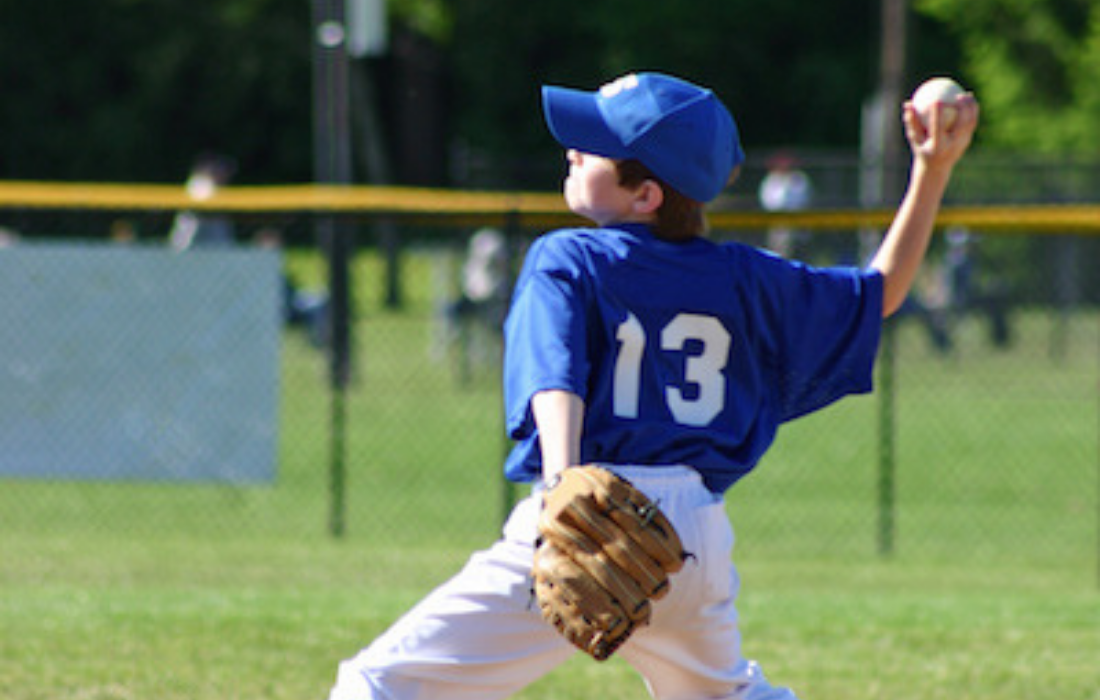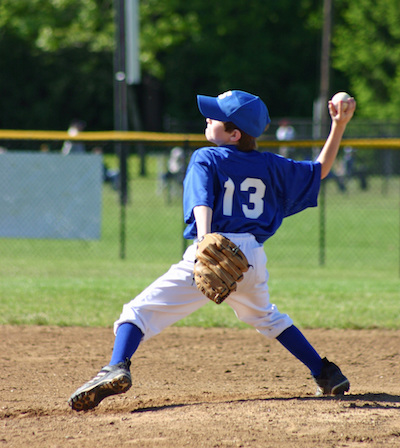Playing Through the Pain: Overuse Injuries in Pediatric Sports

 Over-exertion, overscheduling, and insufficient rest can result in serious injuries to developing children. It has been estimated that among the 60 million children between the ages of 6 and 18 years that participate in an organized sport, approximately 46-54% of injuries associated with this statistic are due to overuse.*
Over-exertion, overscheduling, and insufficient rest can result in serious injuries to developing children. It has been estimated that among the 60 million children between the ages of 6 and 18 years that participate in an organized sport, approximately 46-54% of injuries associated with this statistic are due to overuse.*
Pediatric overuse injuries, as opposed to acute injuries, result from the repetitive application of force over a period of time. These injuries are notably common among children whose bones are still developing and growing, and therefore are not as strong as the bones of older adolescents and adults. In addition to bones, overuse injuries can affect multiple areas and systems of the body, including muscles, ligaments, tendons, and growth plates.
Causes of Overuse Injuries
Overuse injuries are on the rise primarily due to a phenomenon called “sports specialization,” which refers to focus participation in a single sport for a long period of time. This prolonged engagement in certain sport-specific movements can result in overuse injuries. Dr. Kenneth Swan elaborates on this point, stating, “The increase in overuse injury rates is partly due to increased pressure to specialize at an earlier age, and the participation on multiple teams that play all year round.”
Furthermore, Dr. Swan suggests that the “old adage” of more being better does not apply in this case, and that children are being put at increased risk by participating in year- round sports. Constant conditioning for a single sport coupled with inadequate resting time has shown to be the main driver of pediatric overuse injuries.
Common Overuse Injuries
Stress Fractures
Stress fractures are some of the most common overuse injuries that affect children. Stress fractures are small cracks in the bone that occur as a result of repetitive force applied to that particular area of the body. These fractures are most often a result of overuse rather than acute injury. With consistent exposure to repetitive movements, the muscles in the area eventually become unable to effectively mitigate this stress. The failure to properly transfer the pressure generated by this stress results in a fracture forming on the bone. In a recent presentation given on stress fractures and overuse injuries, Dr. Charles Gatt of UOA stated, “Clinical symptoms for stress fractures typically start about three weeks into a training season.”
Below is a brief overview of the most common stress fractures found among children.
Tibial Stress Fracture
Tibial stress fractures refer to fractures sustained to the lower leg bone or shin. Patients suffering from tibial stress fractures generally experience a slow onset of pain that is localized on the shin. This pain typically worsens with increased activity and decreases with rest. In more severe cases, daily movements, including walking, can aggravate these symptoms.
The tibia can also be subject to what is commonly known as “shin splints”, chronic pain around the shin and may or may not be indicative of a stress fracture. Tendonitis and compartment syndrome are two other possible causes of shin pain, and proper diagnosis is necessary in order to develop the appropriate treatment plan. UOA is currently collecting data to develop a shin pain scoring system (SPSS) in an attempt to predict stress fractures among athletes.
Foot Stress Fracture
Foot stress fractures, medically known as “metatarsal fractures”, refer to fractures sustained in one of the five long bones (or metatarsals) of the foot. These fractures occur as a result of excessive contracting of the muscles surrounding the metatarsals. The most common foot stress fractures occur on the second metatarsal, which is the toe directly adjacent to the big toe, and the navicular, which is the bone located at the top of the foot’s arch. In fact, weight-bearing activities, such as running and jumping, are the most typical culprits in navicular stress fractures, and consequently commonplace with children, as the navicular is the last foot bone to fully ossify and fuse into solid bone.
Sever’s Disease (calcaneal apophysitis)
Sever’s Disease is a painful disorder that results from the swelling of the growth plate located in the heel of the foot. Growth plates—also called epiphyseal plates—are located at either end of bones that have not fully ossified yet and are still in the process of growth and development. These plates are composed of cartilage cells that allow for expansion during growth, and ultimately transform into bone cells over time. A swollen growth plate in the heel of the foot is an injury specific to children, typically affecting individuals between the ages of 8 and 15, with a greater rate of occurrence among male children. Because growth plates have already fused in older adolescents and adults, Sever’s Disease is found almost exclusively in the foot bones of children.
Osgood-Schlatter Disease
Osgood-Schlatter Disease is characterized by an inflammation of the cartilage, tendon, or bone at the top of the shin where the kneecap tendon attaches. In some cases, a painful lump presents below the kneecap in children and adolescents. This indication of Osgood-Schlatter Disease occurs as a result of the body attempting to close the gaps caused by the disease around the knee with new bone growth. The disease can occur as a result of activities such as running and jumping on hard surfaces such as a track, or from the swift changes in direction typical sports like hockey, figure skating, and basketball. Osgood-Schlatter has traditionally been more common among boys than girls, but as participation in sports by girls continues to increase, this pattern has begun to change.
Little League Elbow
Little League elbow refers to the injury that results from cyclic stress on the growth plate of the elbow. The greatest cyclic stress occurs during the acceleration phase of the movement involved in throwing a baseball. This injury is found primarily among pitchers, however Little League elbow has been found in individuals occupying other high-volume throwing positions such as shortstop and outfielder.
Dr. James Monica of UOA addressed these baseball-specific overuse injuries in a recent press release, stating, “Baseball has seen an incredible rise in ulnar collateral ligament injuries, which can be linked to the number of throws that occur over the year. Athletes pitch on multiple teams and often are pitching when they are fatigued. In response to the increase in injuries, Major League Baseball (MLB) has created pitch guidelines called ‘Pitch Smart,’ which looks to limit the innings pitched and number of throws made during a calendar year.”
Based on years of research by experts studying the behaviors that put amateur pitchers at risk for injury, Pitch Smart is a series of age-appropriate recommendations for parents, coaches and young athletes created by MLB and USA Baseball™ in order to reduce arm injures and promote safe pitching practices. Additionally, Pitch Smart also lists a variety of risk factors involved with these types of overuse injuries, such as pitching on consecutive days and/or while suffering from injuries to other areas of the body. The expert physicians at UOA highly endorse the techniques and practices presented by Pitch Perfect.
Diagnosis and Treatment of Overuse Injuries
Overuse injuries can be particularly difficult to diagnose for a number of reasons. Generalized—rather than localized—pain can sometimes be the result of multiple micro-traumas. In addition, sports-related injuries often go unreported or ignored to avoid interrupting participation in practices and games. Nevertheless, overuse injuries can be properly diagnosed through a combination of assessing individual medical histories and physical examinations conducted by a doctor specializing in sports medicine. In some cases, X-ray, a bone scan, or magnetic resonance imaging (MRI) may be required to confirm a suspected overuse injury.
Treating overuse injuries typically involves a combination of rest, anti-inflammatory medicines, and physical therapy, with the course of treatment depending on the specifics of the injury itself.
UOA is World-class in Treating Sports-related Injuries
UOA is the leader in comprehensive care for all sports-related injuries and conditions, with an award-winning, caring and compassionate staff of certified sports medicine physicians. Our all-in-one facility allows us to best serve your needs, from prevention and diagnosis to treatment and rehabilitation. UOA works with every athlete from the child to the professional to the weekend warrior, developing the best treatment plan to return athletes to the field. We also offer a complete variety of non-surgical solutions and specialize in the latest in minimally invasive procedures.
To learn more about what UOA can do for your child athlete, read about our pediatric sports medicine capabilities.
*National Council on Youth Sports. Report on trends and participation in organized youth sports. 2008.
Additional Resources:
- The American Orthopaedic Society for Sports Medicine
- Consequences of Single Sport Specialization in the Pediatric and AdolescentAthlete
- Overuse Injuries in Youth Sports by Dr. Charles J. Gatt, Jr.
- Return to Running Program developed by Steven L. Cole, ATC, CSCS
- Suggestions for those with Bony Stress Injury/Fracture

